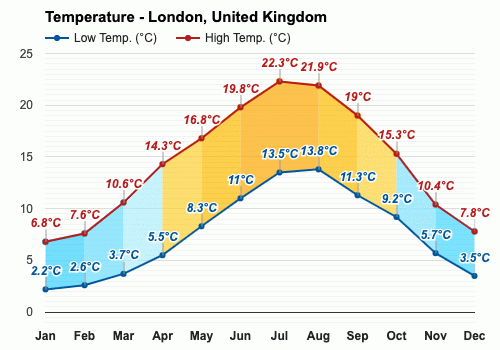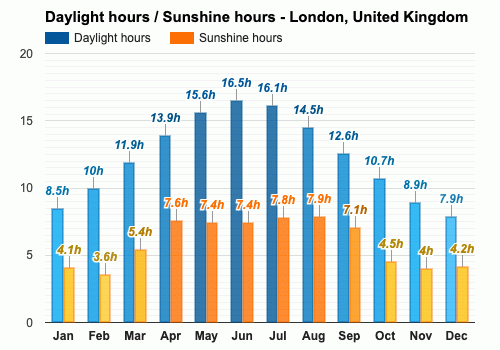Contents
- The climate of London
- The best time to visit London
- The worst time to visit London
- Spring weather in London
- Summer weather in London
- Autumn weather in London
- Winter weather in London
- Weather in January
- Weather in February
- Weather in March
- Weather in April
- Weather in May
- Weather in June
- Weather in July
- Weather in August
- Weather in September
- Weather in October
- Weather in November
- Weather in December
- Frequently asked questions
- Average temperature
- Average pressure
- Average wind speed
- Average humidity
- Average rainfall
- Average rainfall days
- Average snowfall
- Average snowfall days
- Average daylight
- Average sunshine
- Average sunshine days
- Average UV index
- Average cloud cover
- Average visibility

The climate of London
Overall, London's weather swings are moderate, with rainfall occurring relatively evenly throughout the year. The volume of rainfall increases slightly from June to August, peaking at 45mm (1.77") in June, and reaches its lowest at 22mm (0.87") in April. Snowfall, on the other hand, is quite rare and typically occurs only in the months from December till February with a significant drop afterward.
As for temperature, the summer months from June to August have a higher temperature range from 19.8°C (67.6°F) to 22.3°C (72.1°F), while the winter months from December to February experience a lower range from 2.2°C (36°F) to 7.8°C (46°F). London's relative humidity remains consistent around mid-70s to high 80s%. Daylight hours are longer in the summer months with up to 16.5 hours per day in June, and shorter in winter, dwindling to a mere 7.9 hours per day in December.
The best time to visit London
The worst time to visit London
Spring weather in London
Summer weather in London
Autumn weather in London
Winter weather in London
Weather in January
Weather in February
Weather in March
Weather in April
Weather in May
Weather in June
Weather in July
Weather in August
Weather in September
Weather in October
Weather in November
Weather in December
Published by: Weather Atlas | About Us
Data Sources | Weather Forecasting & Climate
Frequently asked questions
What are the coldest months in London?
How many days does it rain in London?
When does it snow in London?
How much does it snow in London?
When is the lowest UV index in London?
What is the snowiest month in London?
What is the month with the least sunshine in London?
What is the driest month in London?
When it does not snow in London?
What is the rainiest month in London?
When are the longest days in London?
What is the month with the highest UV index in London?
What time of the year is the hottest in London?
What is the least humid month in London?
What month has the most sunshine in London?
When is Daylight Saving Time (DST) in London?
What is the most humid month in London?
What is the month with the shortest days in London?
Average temperature
London, United Kingdom

The warmest month (with the highest average high temperature) is July (22.3°C).
The month with the lowest average high temperature is January (6.8°C).
The month with the highest average low temperature is August (13.8°C).
The coldest month (with the lowest average low temperature) is January (2.2°C).
Average pressure
London, United Kingdom

- Average pressure in January:
1014.6mbar - Average pressure in February:
1013.9mbar - Average pressure in March:
1015.5mbar - Average pressure in April:
1015.7mbar - Average pressure in May:
1016.8mbar - Average pressure in June:
1016.2mbar
- Average pressure in July:
1015.3mbar - Average pressure in August:
1014.9mbar - Average pressure in September:
1016.9mbar - Average pressure in October:
1015.1mbar - Average pressure in November:
1010.6mbar - Average pressure in December:
1014.5mbar
The month with the highest atmospheric pressure is September (1016.9mbar).
The month with the lowest atmospheric pressure is November (1010.6mbar).
Average wind speed
London, United Kingdom

- Average wind speed in January:
16.5km/h - Average wind speed in February:
17.3km/h - Average wind speed in March:
15.9km/h - Average wind speed in April:
13.3km/h - Average wind speed in May:
13.4km/h - Average wind speed in June:
13km/h
- Average wind speed in July:
12.7km/h - Average wind speed in August:
12.8km/h - Average wind speed in September:
12.6km/h - Average wind speed in October:
14.3km/h - Average wind speed in November:
15.5km/h - Average wind speed in December:
17km/h
The windiest month (with the highest average wind speed) is February (17.3km/h).
The calmest month (with the lowest average wind speed) is September (12.6km/h).
Average humidity
London, United Kingdom

The month with the highest relative humidity is December (88%).
The month with the lowest relative humidity is August (72%).
Average rainfall
London, United Kingdom

The wettest month (with the highest rainfall) is June (45mm).
The driest month (with the least rainfall) is April (22mm).
Average rainfall days
London, United Kingdom

- Average rainfall days in January:
11.2 days - Average rainfall days in February:
10.5 days - Average rainfall days in March:
11.5 days - Average rainfall days in April:
13.1 days - Average rainfall days in May:
14.3 days - Average rainfall days in June:
16 days
- Average rainfall days in July:
16.5 days - Average rainfall days in August:
13.5 days - Average rainfall days in September:
9.8 days - Average rainfall days in October:
11.6 days - Average rainfall days in November:
12.6 days - Average rainfall days in December:
11.1 days
The month with the highest number of rainy days is July (16.5 days).
The month with the least rainy days is September (9.8 days).
Average snowfall
London, United Kingdom

The month with the highest snowfall is February (16mm).
The months with the least snowfall are May, June, July, August, September and October (0mm).
Average snowfall days
London, United Kingdom

- Average snowfall days in January:
2.2 days - Average snowfall days in February:
2.5 days - Average snowfall days in March:
1.2 days - Average snowfall days in April:
0.3 days - Average snowfall days in May:
0 days - Average snowfall days in June:
0 days
- Average snowfall days in July:
0 days - Average snowfall days in August:
0 days - Average snowfall days in September:
0 days - Average snowfall days in October:
0 days - Average snowfall days in November:
0.3 days - Average snowfall days in December:
1.2 days
The month with the highest number of snowfall days is February (2.5 days).
The months with the least snowfall days are May, June, July, August, September and October (0 days).
Average daylight / Average sunshine
London, United Kingdom

- Average daylight in January:
8h and 2min - Average daylight in February:
10h and 0min - Average daylight in March:
11h and 5min - Average daylight in April:
13h and 5min - Average daylight in May:
15h and 4min - Average daylight in June:
16h and 4min
- Average daylight in July:
16h and 1min - Average daylight in August:
14h and 4min - Average daylight in September:
12h and 4min - Average daylight in October:
10h and 4min - Average daylight in November:
8h and 5min - Average daylight in December:
7h and 5min
The month with the longest days is June (Average daylight: 16h and 36min).
The month with the shortest days is December (Average daylight: 7h and 54min).
- Average sunshine in January:
4h and 1min - Average sunshine in February:
3h and 4min - Average sunshine in March:
5h and 2min - Average sunshine in April:
7h and 4min - Average sunshine in May:
7h and 2min - Average sunshine in June:
7h and 2min
- Average sunshine in July:
7h and 5min - Average sunshine in August:
7h and 5min - Average sunshine in September:
7h and 1min - Average sunshine in October:
4h and 3min - Average sunshine in November:
4h and 0min - Average sunshine in December:
4h and 1min
The month with the most sunshine is August (Average sunshine: 7h and 54min).
The month with the least sunshine is February (Average sunshine: 3h and 36min).
Average sunshine days
London, United Kingdom

- Average sunshine days in January:
16.8 days - Average sunshine days in February:
15.1 days - Average sunshine days in March:
16.2 days - Average sunshine days in April:
14.8 days - Average sunshine days in May:
14.1 days - Average sunshine days in June:
12.2 days
- Average sunshine days in July:
12.3 days - Average sunshine days in August:
15.5 days - Average sunshine days in September:
18.1 days - Average sunshine days in October:
16.8 days - Average sunshine days in November:
15.4 days - Average sunshine days in December:
17.5 days
The month with the most sunshine days is September (18.1 days).
The month with the least sunshine days is June (12.2 days).
Average UV index
London, United Kingdom

The months with the highest UV index are June and July (UV index 5).
The months with the lowest UV index are January, February, November and December (UV index 2).
Average cloud cover
London, United Kingdom

The month with the most cloud cover is February (Cloud cover 61).
The month with the least cloud cover is September (Cloud cover 49).
Average visibility
London, United Kingdom

The months with the highest visibility are January, February, March, April, May, June, July, August, October and December (9km).
The months with the lowest visibility are September and November (8km).
London, United Kingdom
Weather forecast for your location
2. Allow the app to use your location


